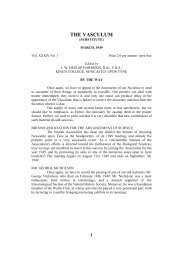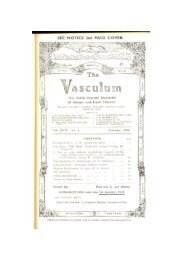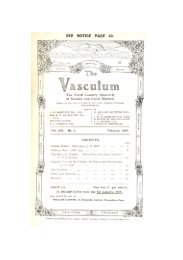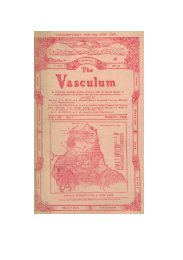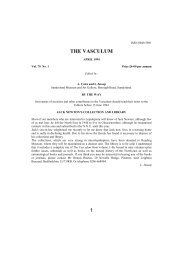1972 - The Vasculum
1972 - The Vasculum
1972 - The Vasculum
You also want an ePaper? Increase the reach of your titles
YUMPU automatically turns print PDFs into web optimized ePapers that Google loves.
31<br />
VASCULUM VOL. LVII. No. 3. <strong>1972</strong><br />
project has been undertaken on the algae of streams in Upper Teesdale. <strong>The</strong> results of this project will be<br />
published in more detail elsewhere, but we felt that a brief account here might be of some interest to local<br />
naturalists. We felt too that it may prove an useful introduction to the following paper by Mr. J.R. Carter on<br />
diatoms. Our note deals only with one stream on Widdybank Fell, Slapestone Sike, but many of the features<br />
described for this stream are common to the majority of streams associated with the metamorphosed limestone<br />
(see Johnson et al. 1971) in Upper Teesdale.<br />
Slapestone Sike was one of the largest streams draining the metamorphosed limestone area,<br />
running through one of the areas richest in interesting species of flowering plants. Although the lower reaches of<br />
the stream are now drowned in the Cow Green Reservoir, about half the length of stream of special interest still<br />
remains. In the upper reaches the stream flows over small boulders, but in the steeper reaches of the stream below<br />
the present road (Birkdale Track) the water flows directly over the limestone. <strong>The</strong> part of the stream drowned by<br />
the reservoir consisted of the lower part of the steep limestone slope, including several vertical waterfalls, a short<br />
reach with boulders not unlike the present uppermost reach, and finally a long narrow meandering reach running<br />
through the peat and with a substrate of black peaty silt.<br />
Slapestone Sike showed very marked variations in flow during the period under study, with large<br />
areas of the stream left dry under low flow conditions. However it seems improbable that the stream ever dries out<br />
completely in winter.<br />
A number of small tributaries entered Slapestone Sike, and five of these now remain above<br />
reservoir high water mark. <strong>The</strong>se varied markedly in their general characteristics, and only three (B, C, D in Table<br />
I) are mentioned here. <strong>The</strong>se three originate from springs which show signs of having been opened out during the<br />
period when mining for lead and barytes was in progress. B is a ditch which drains into the left-hand side of the<br />
stream above the road; C is a narrow channel entering on the right-hand side just below the road; D is a spring on<br />
the left-hand side just above the present reservoir high-water mark. Band D always maintained a vigorous flow<br />
even after long periods of low rainfall, but C nearly dried out on several occasions.<br />
WATER CHEMISTRY<br />
Some details of the chemistry of Slapestone Sike water (analysed by methods given in Holrnes et al., <strong>1972</strong>) are<br />
summarised in Table I. Although the values for only a single day are shown, they are nevertheless typical of those<br />
obtained during periods of low flow. As compared with other (about 40) upland streams and rivers under study in<br />
North-East England, the most striking features of Slapestone Sike and the other streams associated with the<br />
metamorphosed limestone are the very low levels of Mg and K. For both elements the values for Slapestone Sike<br />
are lower than for any other stream away from Upper Teesdale under similar conditions of low flow. <strong>The</strong>re are<br />
also some indications that the levels of combined inorganic N in Slapestone Sike are relatively low (unpublished<br />
data).



